At CarnivoreWeb.com, we independently review products and outfitters. However, we may earn a commission when you purchase products through links on our site. Read our affiliate policy. Read about how we test products.
Chef Albert Wutsch discusses his unique philosophy to game processing.
You can tell a lot about someone’s field experience by the efficiency and skill at which they dress out a freshly harvested animal. Watching Chef Albert Wutsch masterfully break down a South Texas Wild boar while carefully explaining the process of identifying each muscle and which cooking technique would yield the best results was a unique experience.
Wutsch’s love of the outdoors stretches back to waiting for his father’s return from excursions to the Adirondacks of upstate New York when he was still too young to accompany him. He and his two brothers would eagerly await their dad’s homecoming so they could listen to the tales of his adventures and eat the delicious rewards of a successful hunt. As the boys became of age, they began to accompany their father, uncles, and cousins on these trips, gaining just as much in experience as they did passion for the outdoors. This led to joining the Boy Scouts, with all the Wutsch boys attaining the rank of Eagle Scout. It was during his climb through the scouting ranks that Albert was introduced to cooking, in the form of requirements for different badges, thus laying the foundation for his future outdoor culinary exploits. Skills acquired during his scouting days would stay with him; one of the first questions posed to him from an outfitter when applying for a job as a backcountry cook was: “Can you start a fire?”
Wutsch chuckled, “Little did I know I’d be starting fires with flint and steel or two sticks, or carrying a charcoal wrapped in cottonwood bark in my saddlebags.”
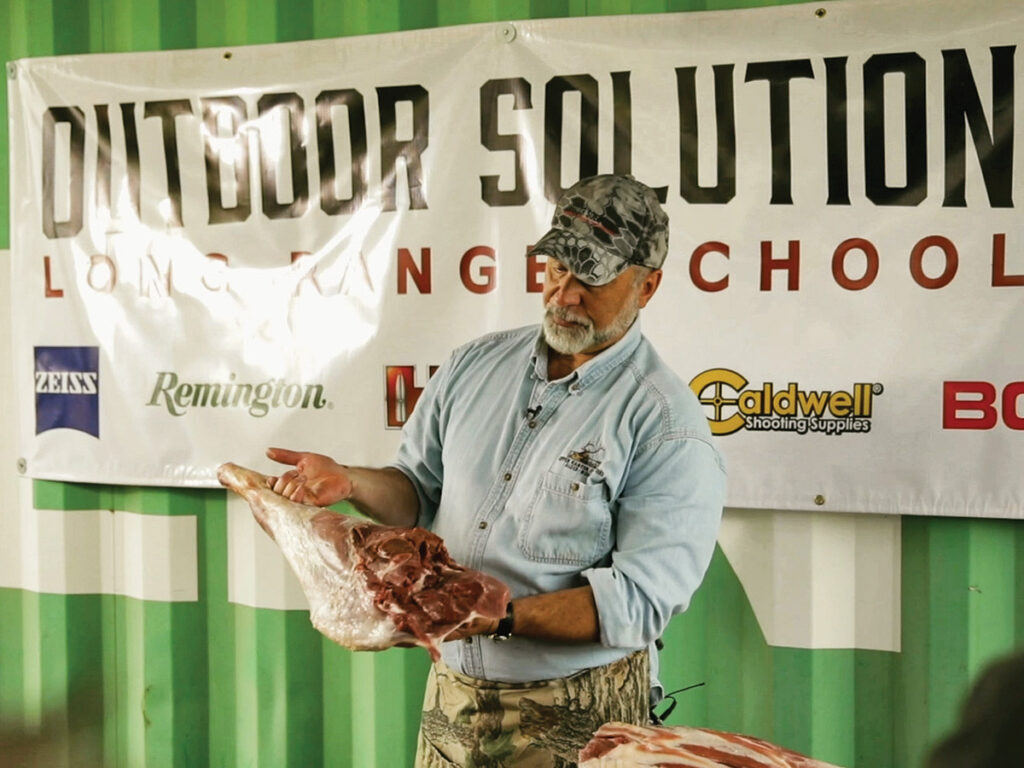
Wutsch enjoyed cooking so much he pursued part-time employment in restaurants as a teen, landing his first job at 15 at a local establishment, the Holly Inn in Bloomingdale, New Jersey, that specialized in classical and French cuisine. By his own account, he lucked into such a positive environment at such a young age, learning the basics of making stocks and mise en place (a culinary process in which ingredients are prepared and organized).
“At the time I didn’t know how important this was, I just knew it was a nice restaurant, and we couldn’t afford to eat there,” Wutsch explained.
These first experiences in professional kitchens made a lasting impression still evident today in his game dishes, such as Venison au Poivre and Pheasant Breast in Candied Orange Butter Sauce.
Like many on the eastern seaboard, his love of the outdoors drove Wutsch west, where he began attending the University of Montana, majoring in Wildlife Management and once again working part time at local restaurants. He’d change his major to culinary arts and switch to the local vocational culinary program after his second year, studying under Chef William Hunter, one of the first certified executive chefs in Montana. Hunter would later become Wutsch’s mentor and supervisor once Wutsch became a teacher’s aide at the school. That led to a full-time faculty position, thus kicking off Wutsch’s career as an educator and a lifelong friendship between the two.
Knowing the origins of Chef Wutsch’s experience is important when looking at what he calls the philosophy of game processing. In his view, proper preparation begins before the trigger is ever pulled, even before the selection of the animal; it starts with the hunter’s mindset, preparation, and tool selection.
“Dad had always taught us to respect the animal life, not to waste. He taught conservation. We were always prepared to handle the meat and for the work that came after the trigger was pulled … ‘I’ll be sitting here sharpening my knife’ is the Wutsch’s official hunting camp song. When hunting with our father, we always fabricated our meat, and over the years developed what I call today our philosophy of game processing. Of course, being a professional chef has had major impact on the process.”
This comes out in Wutsch’s classes as he focuses on every aspect of how the game is handled after harvesting.
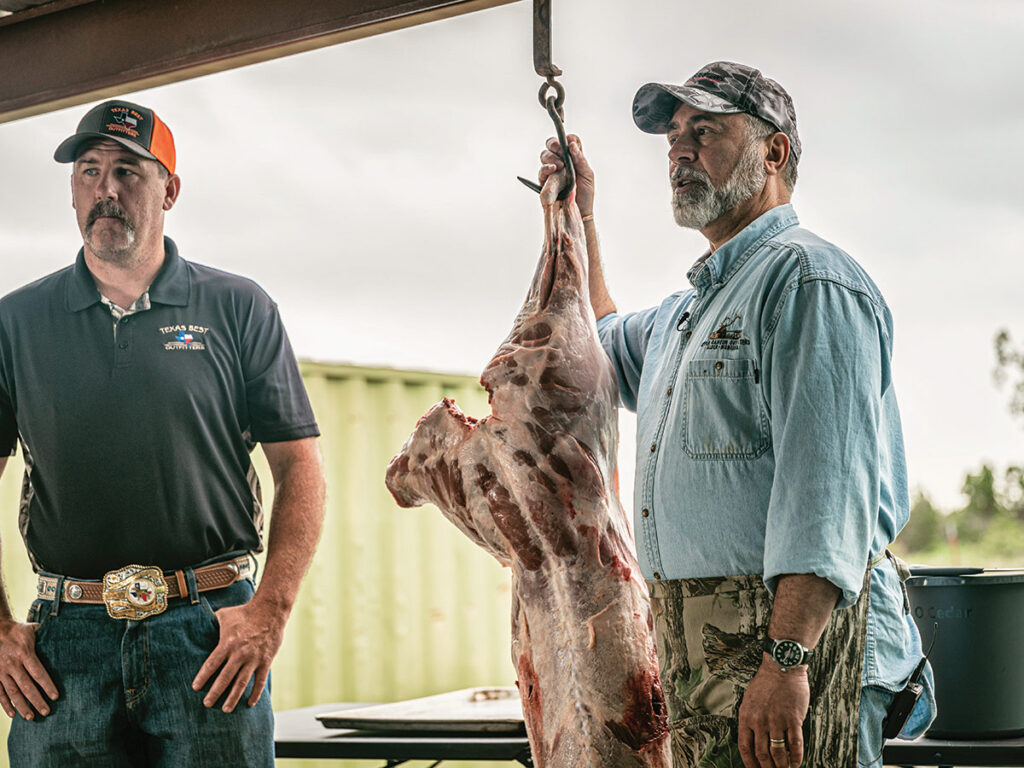
“We teach all the factors that affect the taste and tenderness from the field to the table. There are too many people who love to hunt, but their families don’t like venison, that don’t like the gamey taste because it was mishandled in the field or in the processing procedures. Our objective is to teach people how to make good quality, tender tasty meats. We discuss those factors that affect it; the age of the animal, the diet of the animal, how they were shot, shot placement. Getting the body temperature down as fast as possible and getting the blood out. Doing this while keeping it as clean as possible, no hair or dirt.”
The physical breaking down of the animal after harvesting starts with proper field dressing, and common mistakes can ruin some of the best cuts, according to Chef Wutsch.
“Easy thing not to do, splitting the pelvic bone — I recommend not doing that. The muscle right there at the pelvic bone, that people cut down when they field dress it, is the most abused muscle on the animal. That’s the top round or inside round. You open that up and drag the animal, you’re exposing it. That is the most tender cut in the leg.”
Being able to butcher the animal correctly and efficiently will also save the hunter time and money — two resources most of us are limited on, especially if you’re fortunate enough to harvest multiple animals or species each season. Doing it yourself also allows you to eliminate the ‘What’s in the box?’ guessing game that can result in commercially processed game from your local butcher.
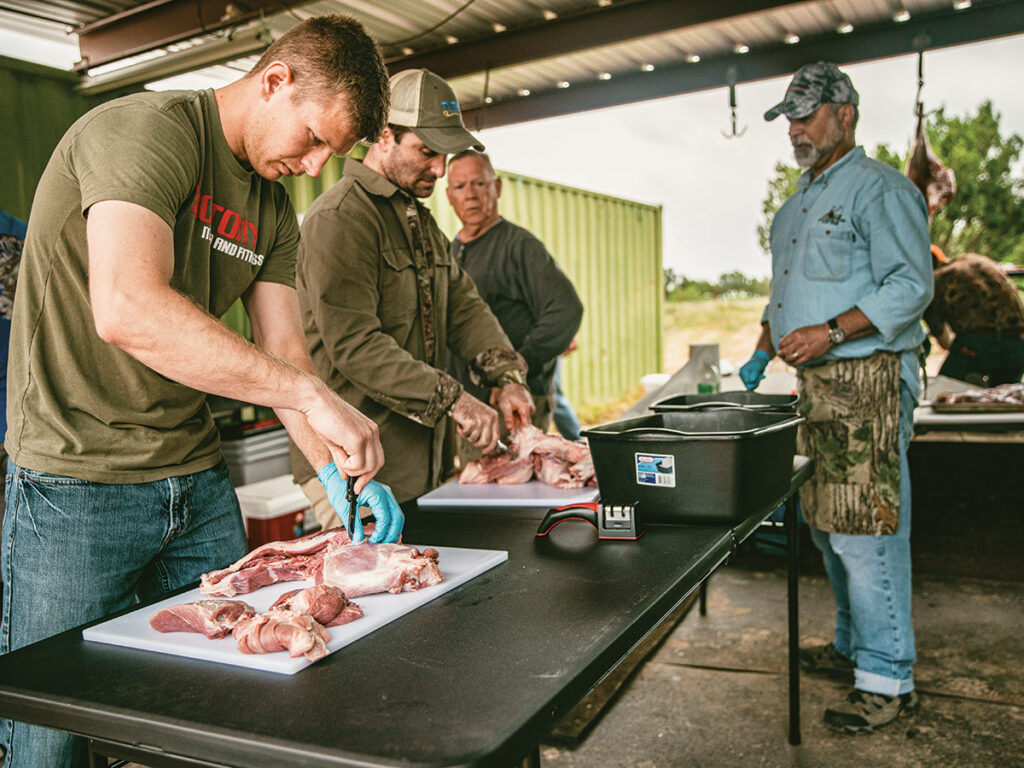
“You never know what you’re going to get; you pull out a package and it says ‘roast,’ and it could be anything from a tender strip roast or a knuckle roast. You end up with something you should be pot roasting slow and low versus something that should be cooked fast and rare.”
There are other advantages as well. One of the most important is being able to either remove the fascia, the thin tacky membrane that covers the muscle, or leave it intact to be removed later during the thawing process prior to preparation. Leaving the fascia on during cooking can lead to off-putting flavors, uneven cooking, and poor presentation. But if you leave the fascia on, especially on the primal cuts, it helps prevent freezer burn and moisture loss by protecting the surface of the muscle while containing the meat in its original packaging. You just remove the membrane from the meat after the surface has thawed slightly.
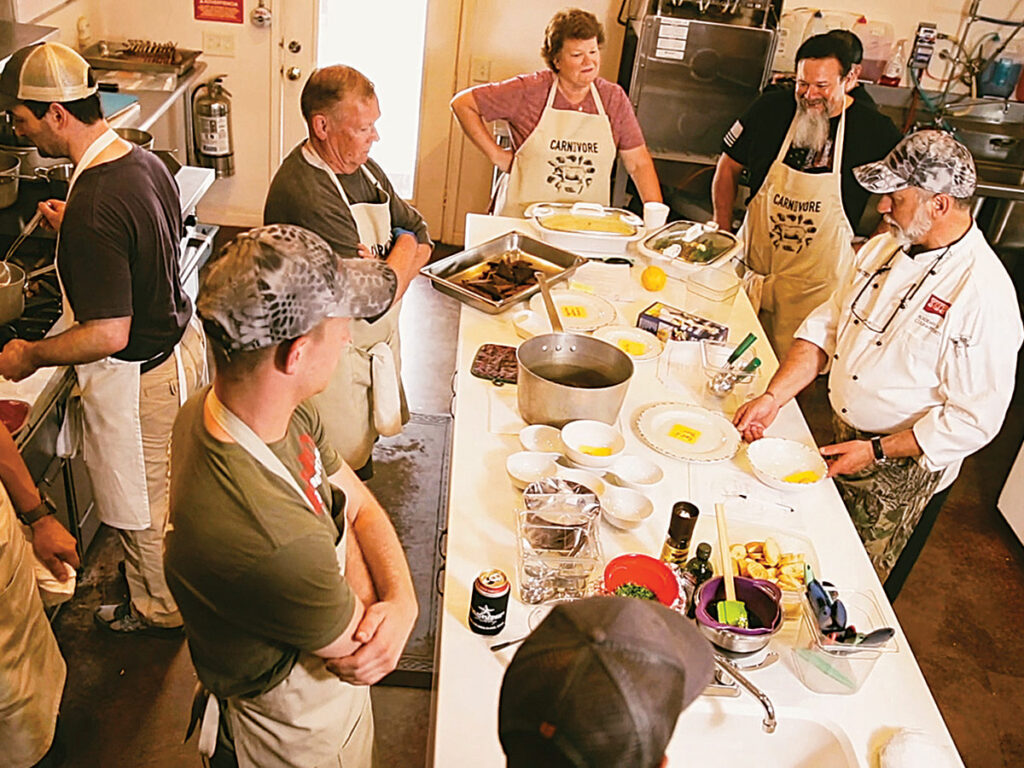
“We don’t recommend people get round stakes out of the hind leg. Everyone used to come to me and ask, ‘How do I cook these steaks in the freezer?’ and they all had round steaks. The butcher, he needs to make money when he cuts up someone’s deer, so they cut that leg up really fast into round steaks. That round steak has three different muscles in it, each one encompassed with that fascia. So, when they put it on the grill it’s going taste gamey, it’s going to contort out of shape, and it’s going to be chewy … but that’s when my wife told me I should write a book because of all these questions on round steak.”
Chef Wutsch teaches hunters to break the game down to primal cuts or into the separate muscles, leaving them intact to be sliced later into steaks, chops, roasts, or stew meat so not to expose too much surface area to the elements and possible contaminates. This is what the RECOIL staff and other industry professionals were able to recently experience in an expedition to the T Diamond Ranch in Texas on a whirlwind hog hunting trip. Wutsch’s professional experience was evident as he showed the hunters how to properly butcher a boar, identify the muscle, and determine the best cooking method to properly prepare each cut. Wutsch constantly concentrated on a simple idea:

“The focus is on getting quality meat from the field to the cutting board. Without quality at the cutting board you really can’t fix it in the pan onto the plate.”
The second half of the day was all about the pan to the plate. It doesn’t do the hunter or animal any justice to take every proper step from the field to the cutting board just to cook the hell out of a beautiful piece of tenderloin that should be cooked hot, fast, and served rare. During the break-down portion, Wutsch identified specific cuts on the animal, also relating them to other types of game and how to select the cooking method.
“From a chef’s perspective, all tender cuts from any animal get dry cooking methods, which are stir fry, sauté, pan fry, deep fry, broil, grill, or roast. Then, the tough cuts get moist cooking methods or combination cooking methods that would be boiling, simmering, braising, or stewing. Then, you have the high fat content meats like boar or bear that you can cook low and slow on the barbecue.”
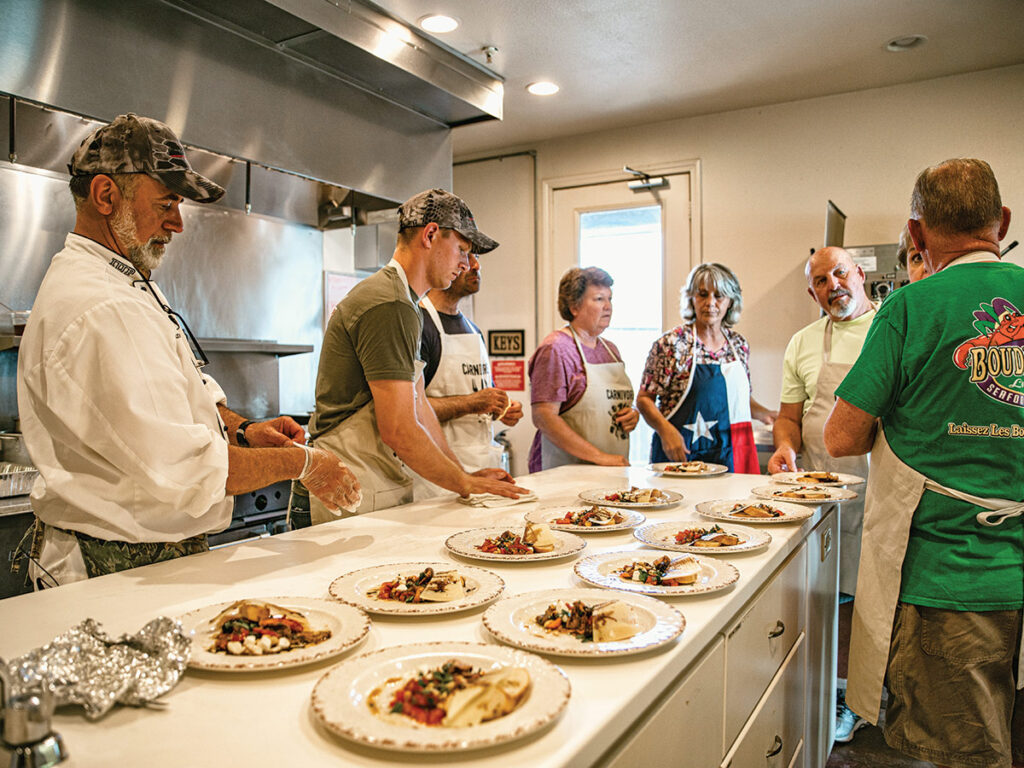
The culmination of Wutsch’s philosophy of game preparation is to serve a tender and tasty dish that highlights the delicious flavors of the animal, completing the journey from field to table for everyone involved in the process. Those who couldn’t share in the hunt can experience a piece of it by enjoying the thoughtfully prepared meal and recounting of the adventure, much like Wutsch’s first exposure as a child through his father. These positive interactions are the way we as hunters and stewards of the outdoors can share our love of the hunt and its rewards with others, ensuring the survival of the sport and way of life.
These days Chef Wutsch along with his wife, Sandy, run Cache Creek Enterprises, traveling the country conducting seminars and demonstrations at various venues a dozen times a year. These vary from four seminars a day, to all day cooking classes, to weeklong hunting camps. This year so far, they’ve visited Virginia, Texas, Pennsylvania, and local events in Montana. He also consults on menu and recipe development for lodges and hunting camps across the nation, while helping the next generation of chefs through recruitment and placement programs.
Wutsch also finds the time to author cookbooks and produce videos. His book The Art of Cooking Venison has sold over 10,000 copies. It’s a cooking manual for all meats, emphasizing his philosophies. The Art of Barbecuing and Grilling Game focuses on these two cooking methods — grilling techniques for the tender cuts and barbecuing for less tender. His next installment The Art of Cooking Game is a compilation and collection of Chef Wutsch’s recipes used in hunting camps, demonstrated at various sports shows, conventions, and seminars across the country and should be available in August.
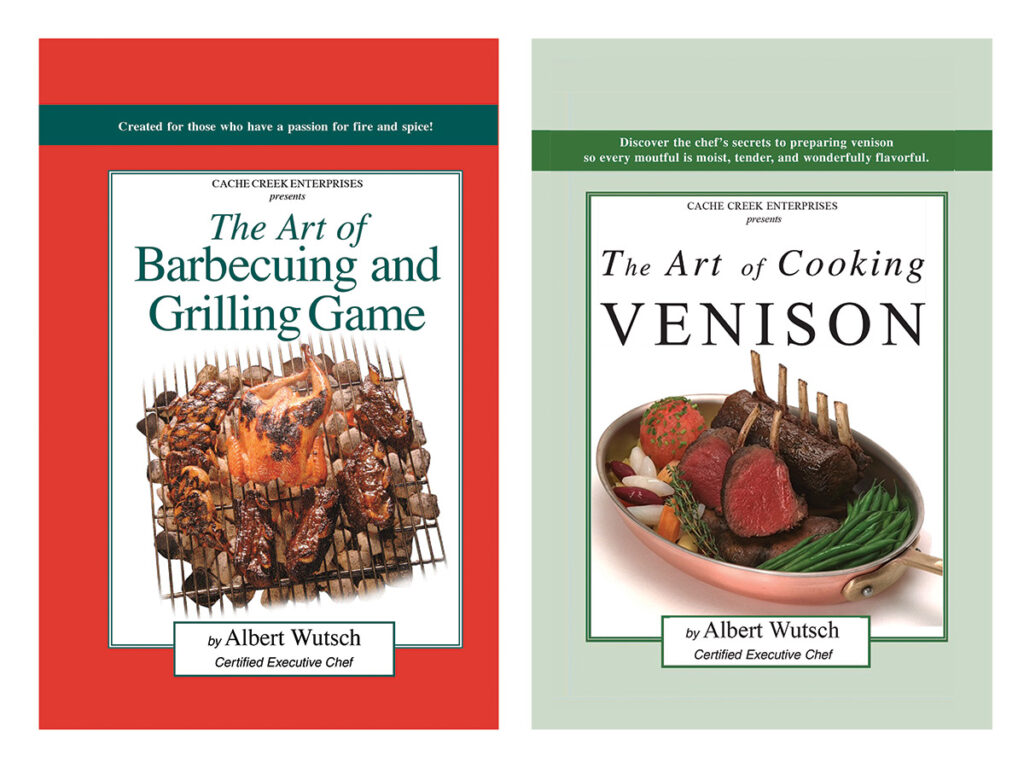
Cache Creek Enterprises: theartofcookingvenison.com.
Editor’s Note: This article originally appeared in Carnivore Magazine Issue 3.
Why You Can Trust CARNIVORE
Since its launch, CarnivoreWeb.com has been a trusted authority on hunting, fishing and wild food, delivering expert insight for outdoorsmen who live the field-to-table lifestyle. More than a hunting and fishing site, CarnivoreWeb.com covers the full spectrum of the modern outdoors—from rifles, bows, and fishing gear to cooking, conservation and adventure.
Our contributors are drawn from across the hunting and angling world, including seasoned guides, lifelong hunters, competitive shooters and outdoor writers with decades of field experience. Every review, article and feature is built on firsthand testing, deep research, and an unwavering commitment to accuracy.
Commitment to Journalistic Principles
At CarnivoreWeb.com, upholding journalistic integrity is our top priority. We follow strict editorial standards to ensure all content is accurate, transparent, and unbiased. Our editors and writers operate independently, free from outside influence, advertisers or stakeholders. We adhere to established journalistic codes of ethics, holding ourselves accountable for the information we publish, correcting errors when they occur and disclosing any potential conflicts of interest.
This commitment ensures that our readers can trust CarnivoreWeb.com to provide reliable, honest coverage that helps them make informed decisions—whether selecting gear, honing outdoor skills or preparing wild game.
Find out more about our Editorial Standards and Evaluation Process


